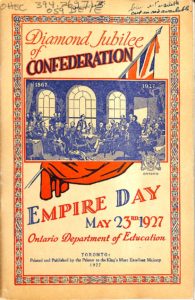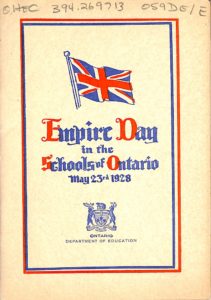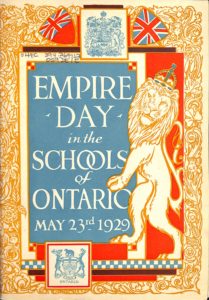On display in the glass table this month is a selection of colonial booklets and programmes used in Ontario schools for Empire Day and Commonwealth Day ceremonies.
Empire Day was first celebrated in Ontario on May 23, 1899. By design, it was intended to coincide with Victoria Day:
The school day immediately preceding the 24th of May shall be devoted specially to the study of the history of Canada in its relation to the British Empire, and to such other exercises as might tend to increase the interest of the pupils in the history of their own country and strengthen their attachment to the Empire to which they belong – such day to be known as ‘Empire Day’. (Circular to Inspectors, 1900)
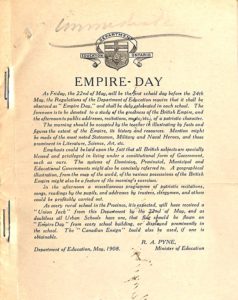 As Empire Day was adopted elsewhere in the British Empire, this convention was not followed. Countries that did not observe Victoria Day instead celebrated Empire Day on May 24th.
As Empire Day was adopted elsewhere in the British Empire, this convention was not followed. Countries that did not observe Victoria Day instead celebrated Empire Day on May 24th.
From the beginning, the purpose of Empire Day was educational: to teach children living in British territories about the British Empire. Furthermore, Empire Day booklets and programmes reflected the colonialism of the period. In addition to containing factual information such as the populations of major cities within the British Empire, these booklets were intended to instill “good British values” such as loyalty to the British Crown in Ontario schoolchildren. Many of these booklets also highlighted themes such as British “valour” and “supremacy.” The 1912 Empire Day booklet, for example, describes Empire Day as a day where “British subjects everywhere celebrate the history, traditions, character, unity and greatness of the British Empire.”
Over the years, the rhetoric used in Empire Day booklets underwent a shift. Instead of promoting the “greatness of the British Empire,” in later years these materials emphasized the importance of good citizenship. 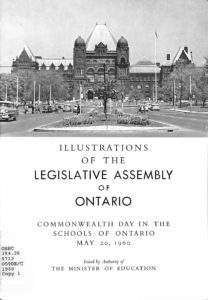 By the 1950s, Empire Day was also informally known as “Citizenship Day.”
By the 1950s, Empire Day was also informally known as “Citizenship Day.”
In 1957, this holiday experienced another shift: Empire Day ceased to be celebrated and was replaced by Commonwealth Day. The emphasis on citizenship remained: in 1958, Citizenship Day was formally recognized in conjunction with Commonwealth Day “to prompt Canadians to reflect on the responsibilities, duties, and privileges of citizenship involving individual rights, love, compassion, and concern for all” (Ontario Ministry of Education, 1982).
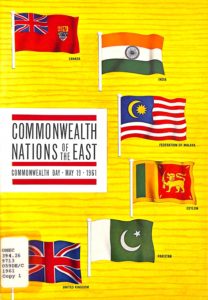 The Commonwealth Day booklets discussed topics such as the opening of the Canadian Parliament, how the Ontario Legislature was run, and surveys of the provinces’ coats of arms and provincial flowers. In addition topics about about Canada, the Commonwealth Day materials also sought to educate Ontario youth about other Commonwealth countries. For several years in the 1960s, for example, these booklets contained profiles of Commonwealth countries in Asia, Africa, the Carribbean, and the Pacific:
The Commonwealth Day booklets discussed topics such as the opening of the Canadian Parliament, how the Ontario Legislature was run, and surveys of the provinces’ coats of arms and provincial flowers. In addition topics about about Canada, the Commonwealth Day materials also sought to educate Ontario youth about other Commonwealth countries. For several years in the 1960s, for example, these booklets contained profiles of Commonwealth countries in Asia, Africa, the Carribbean, and the Pacific:
The Commonwealth of Nations is neither an empire not a power bloc. It is a family of countries, the very survival of which depends upon the maintenance and strengthening of the ties that bind one member to another. This strengthening process can best be achieved by a continued effort to keep citizens of each member country informed about the unique and the shared features of their own and their sister countries. (Commonwealth Day booklet, 1968)
In 1977, the Commonwealth of Nations made a joint decision to move Commonwealth Day from May to the second Monday in March.
These books will be on display in the glass table on the ground floor of the OISE Library through the end of May.

